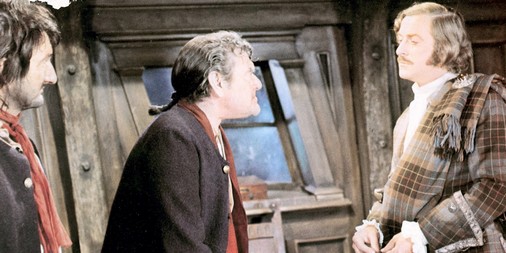
Kidnapped & Catriona
David Stuart looks at two of Robert Louis Stevenson’s classic Scottish tales.
One remarkable aspect of Robert Louis Stevenson’s skill as an author was the range of his writing. His prolific pen created tales of horror, swashbuckling endeavours, mysteries, ghost stories and thrilling historical yarns set in his beloved Scotland. Kidnapped and its sequel Catriona fall into this latter category.
Rather like Treasure Island, Kidnapped was originally written as a rousing tale for young readers. It was first published in serial form in the magazine Young Folks from May to July 1886. The novel is set around real 18th-century Scottish events, which occurred in the aftermath of the Jacobite rising of 1745. In a preparatory note to the novel, Mrs Stevenson explains that her husband was fascinated by this period of history, a time of turmoil and political upheaval, ‘and wanted to write a story in which a young boy, David Balfour, supposed to belong to my husband’s own family, who should travel to Scotland as though it was a foreign country, meeting various adventures and misadventures on the way.’ Many of the characters are real people, including one of the principals, Alan Breck Stewart, the unscrupulous but heroic champion of the Jacobite cause. The exciting sweep and drama of the tale not only engaged the interest of the young but more mature readers also. The novel was very successful and sold well while Stevenson was alive. However, after his death many came to view the book with scepticism, seeing it as simply a boys’ adventure novel, but by the mid-20th century, it had regained critical approval and study. Over time it has attracted the praise and admiration of writers as diverse as Henry James, Jorge Luis Borges and Hilary Mantel.
It is perhaps the skill with which the author weaves his fictional tale in a bold and easy fashion into a version of the historical events he uses as pegs in which to hang his narrative that add that extra depth and quality to the novel. The true events and the period details give colour and richness to the narrative. However, in the preface to Kidnapped Stevenson warns the reader that historical accuracy was not primarily his aim, remarking ‘how little I am touched by the desire of accuracy’. In other words, he is true to the spirit and poetry of the period but is prepared to alter facts to enrich the plot.
The novel easily lends itself to dramatic film, TV and radio adaptations. The first was a silent movie produced in 1917 by Edison Studios in New York. In the thirties when Hollywood was ransacking the bookshelves of all the classic British novels, they came up with their version in 1937 with Warner Baxter as Alan Breck Stewart and the very young Freddie Bartholemew as David Balfour. The simple plotline for this movie read: ‘In 1747, David Balfour’s evil uncle arranges for him to be kidnapped and sent to sea, where he meets exiled Alan Breck. The two make their way back to Scotland and justice’.
Walt Disney gave us his version in 1960, which marked Peter O’Toole’s first screen appearance. More recently there was a television mini-series in 2005 but this playing around with the plot. There has also been an animated feature (1986) and a graphic novel (2007) based on the book.
It was in 1971 that perhaps the most popular cinematic version of Kidnapped appeared. Directed by Delbert Mann, its starry cast included Michael Caine, Trevor Howard, Jack Hawkins and Donald Pleasence, as well as a number of well-known British character actors. One of the interesting aspects of this version was that not only was the movie based on Kidnapped but also on the first half of the sequel, Catriona.
Catriona was first published in 1893 and begins precisely where Kidnapped ends on 25 August 1751 and so in essence provides a seamless continuation of David Balfour’s tale. Although a fictional character, Catriona is presented by the author as the granddaughter of Rob Roy Macgregor – forming a link with another Scottish hero featured, in Sir Walter Scott’s novel, Rob Roy.
After arranging a safe passage to France for his comrade Alan Breck Stewart, David tries to clear their names of involvement in the murder of Colin Campbell of Glenure, the ‘Red Fox’. The political complexities and intrigue surrounding the ‘Appin murder’ make Davidʼs situation appear hopeless as he tries to find a path that will both save Alan Breck and James of the Glens, and keep his own neck out of the hangman’s noose. With his life again in danger, the only person he can trust is Catriona, the daughter of the treacherous James More.
David Balfour becomes romantically entangled with Catriona, a wild-spirited young woman but their relationship is a problematic and tempestuous one. However, Alan Breck has strong words with David in an attempt to get their relationship on an even keel:
‘It’s this way about a man and a woman, ye see, Davie: The weemenfolk have got no kind of reason to them. Either they like the man, and then a’ goes fine; or else they just detest him, and ye may spare your breath – ye can do naething. There’s just the two sets of them – them that would sell their coats for ye, and them that never look the road ye’re on. That’s a’ that there is to women; and you seem to be such a gomeral that ye cannae tell the tane frae the tither.’
As you may gather that after many thrilling episodes the story heads for a happy ending. The novel is part adventure, part romance, and filled with atmospheric and evocative descriptions of old Edinburgh and the surrounding area. Stevenson was particularly pleased with this novel, saying that he would ‘never do a better book.’
Wordsworth has produced a volume that contains both stories so you have the complete David Balfour saga between one set of covers.